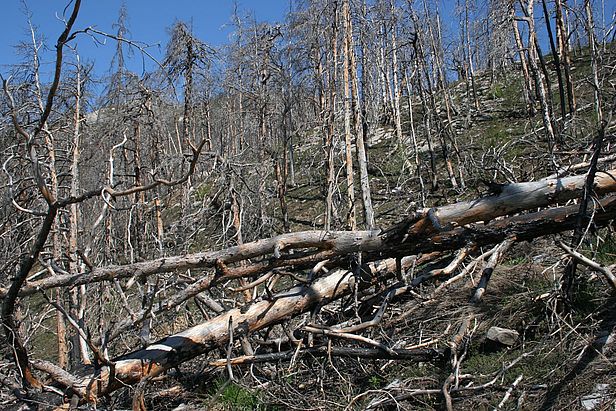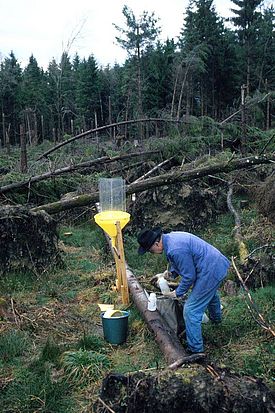05.11.2020 | Editing: Rahel Künzler | News WSL
Please do not disturb: After forest fires, storms and other disurbances, the affected forests should not be cleared. Researchers report this in the journal Nature Communications.
Storms, fires, bark beetles: Many forests around the world are increasingly affected by these and other natural disturbances. It is common practice to eliminate the consequences of these disturbances – in other words, to harvest damaged trees as quickly as possible. Spruce trees attacked by bark beetles are removed from the forest, as are dryed beeches or trees thrown to the ground by storms.
"However, this practice is an additional disturbance that has a negative impact on biodiversity," says Simon Thorn, forest ecologist from Julius-Maximilians-Universität (JMU) Würzburg in Bavaria, Germany. During such logging operations, soil is damaged, most dead wood is removed and structures such as folded up root plates are lost. That is why forest ecologists recommends to exclude a certain proportion of such disturbed forests from overall logging operations.
How much damaged forest to leave?
Forests in which natural disturbances are preserved without human intervention are among the most threatened habitats in the world. They are home for specialized plants, birds, insects and mushrooms, that occur only in these areas. Until now, there have been no concrete figures on what proportion of the area in a forest should be left alone after natural disturbances in order to promote this biodiversity as much as possible.
To close this gap, an international research team with participation of the Swiss Federal Institute for Forest, Snow and Landscape Research WSL has analyzed a global dataset on natural forest disturbances. In the journal Nature Communications, the scientists conclude that leaving around 75 percent of a naturally disturbed forest area not cleared will preserve 90 percent of its original species richness. If only half of a disturbed forest is left untouched, around a quarter of the species will be lost. "These numbers can serve as a simple rule of thumb for leaving natural disturbances in forests unlogged," says Thorn.
“In Switzerland, there has been a process of rethinking since the two major storms Vivian and Lothar and the forest fire in Leuk in 2003,” says Beat Wermelinger, forest entomologist at the WSL and co-author of the study. The decision to leave the wood and allow natural forest development is made more frequently. However, forest managers still often give higher priority to the threat of bark beetle infestations and the sale of wood. To the present study, Beat Wermelinger and the WSL zoologist Martin Obrist contributed data on arthropod communities on storm damaged areas in Switzerland.
Contact
Links
Publications
Copyright
WSL and SLF provide the artwork for imaging of press articles relating to this media release for free. Transferring and saving the images in image databases and saving of images by third parties is not allowed.


